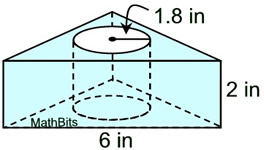|
Directions: Read carefully and choose the best answer.
1. |
A right triangular prism is shown at the right. The bases are isosceles triangles.
a) Find the volume of the prism. |
|
|
Choose:
 |
| |
b) A plane slices the prism, as shown, parallel to the bases. Find the area of the cross section created by the slice. |
 |
| |
c) Find the surface area of the prism to the nearest square inch. |
Choose:
|
|
2. |
Given a cube, with vertices as labeled, and with a lateral side length of 10 cm.
a) Find the measure of ∠FBH. |
|
|
|
| |
b) Find the area of ΔFBH in square centimeters.
|
Choose:
|
|
| |
c) Find the volume of the cube in cubic centimeters. |
Choose:
|
|
3. |
A right circular cylinder is shown at the right. A plane slices the cylinder parallel to the bases.
a) Find the area of the cross section.
|
|
|
Choose:
|
| |
b) Find the volume of the portion of the cylinder below the cross section. |
Choose:
|
|
4. |
A regular hexagonal prism has the measurements as shown. Find its volume to the nearest tenth of a cubic unit. |
|
|
|
5. |
A right circular cylinder is given. A slice perpendicular to the bases creates the cross section shown. The length from the center of the base perpendicular to the cross section is 3 inches, and the height of the cylinder is 18 inches. If the volume of the cylinder is 450π cubic inches, what is the area of the cross section? |
|
|
|
|
A cube is sliced as shown. Find the area of the cross section formed by the slice.
Choose:
|
|
|
7. |
Find the lateral surface area of a cylinder whose volume is 192π cubic units and whose height is 12 units.
Choose:
|
|
8. |
A 90º wedge is removed from a right circular cylinder with a radius of 9 inches and a height of 2 feet. Which choice is the volume of the remaining portion of the cylinder? |
|
|
|
9. |
In the closed cylinder shown at the right, the height is equal to the radius. The total surface area of the cylinder is 576 square inches. Find the exact length of the radius in inches. |
|
|
|
10. |
A right, regular, triangular prism has a circular cylindrical hole through its center. Which of the following statements are true regarding this solid?
(Check all that apply, and hit SUBMIT!) |
 |
| |
|

NOTE: The re-posting of materials (in part or whole) from this site to the Internet
is copyright violation
and is not considered "fair use" for educators. Please read the "Terms of Use". |
|